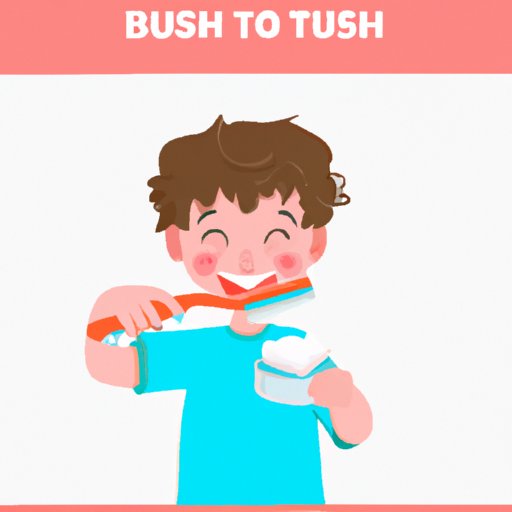I. Introduction
Dental hygiene is an essential aspect of overall health. Neglecting it can lead to a wide range of consequences, from bad breath to gum disease and even tooth loss. However, maintaining healthy dental hygiene can be a simpler process than many people realize. In this article, we will provide you with a comprehensive guide on how to brush your teeth properly, the importance of brushing, common mistakes to avoid, product reviews, and the link between dental health and overall wellness.
II. Step-by-Step Guide
The first step towards a bright and healthy smile is knowing how to brush your teeth correctly. Here’s a step-by-step guide:
- Choose Your Tool: Select a soft-bristled toothbrush that is easy and comfortable to use. Electric and manual toothbrushes are both effective, so pick the one that suits your preference.
- Add Toothpaste: Squeeze a pea-sized amount of fluoride toothpaste onto the bristles of your toothbrush.
- Proper Brushing Technique: Hold your toothbrush parallel to your teeth, and brush in circular motions, focusing on the gum line. Make sure to cover each tooth’s surface, the front, back, and the chewing surfaces. Tilt the brush vertically and use gentle strokes to clean the inner surfaces of the front teeth. Brush your tongue and roof of your mouth to remove bacteria that cause bad breath.
- Brush long enough: Brush your teeth twice a day for at least two minutes each time. Use a timer or an electric toothbrush’s timer feature to help keep track of time.
- Maximizing Efficiency: Floss between your teeth daily to remove food particles and prevent plaque buildup. Finish with mouthwash for added freshness and antibacterial protection.
III. Common Mistakes
Despite the simplicity of brushing, many people make common mistakes that can damage their teeth. Some of these mistakes include:
- Overbrushing or Brushing Too Hard: Overbrushing or brushing too hard can cause gum recession and damage your tooth enamel.
- Not Brushing Long Enough or Frequently Enough: Neglecting to brush frequently or for an adequate length of time can lead to cavities and bacteria buildup.
- Incorrect Brushing Technique: Brushing in a back-and-forth motion, neglecting the gum line, and not Rinse your brush after brushing or letting it air dry after use.
IV. Importance of Brushing
Brushing your teeth is crucial for maintaining good oral hygiene. While some benefits of brushing are apparent, like fresh breath and a bright smile, other benefits are less visible. Here are some of the consequences of neglecting good oral hygiene:
- Cavities and tooth decay
- Gingivitis and periodontal disease
- Loss of teeth
- Infections that impact overall health
Alternatively, here are some of the benefits of maintaining good oral care:
- Prevents cavities and tooth decay
- Prevents gingivitis and periodontal disease
- Reduces the need for dental treatments in the future
- Prevents bad breath, tooth stains, and unpleasant taste in the mouth
- Boosts self-confidence and self-esteem
V. Product Reviews
Choosing the right products for your dental hygiene routine can help you achieve healthy teeth and gums. Here are some of the essential dental hygiene products:
- Toothbrushes: Both electric and manual toothbrushes are effective in cleaning your teeth. However, electric toothbrushes are generally more efficient, removing plaque more effectively than manual brushes. Consider the shape and size of the brush head, the bristle texture, and handle comfort when purchasing a toothbrush.
- Toothpaste: Fluoride toothpaste is the most effective toothpaste in preventing cavities and tooth decay. However, some people prefer natural or organic toothpaste. Toothpaste that contains whitening components can be helpful in removing tooth stains.
- Floss: Flossing is essential in maintaining healthy teeth and gums. There are many dental floss types, including traditional floss, water flossers, and interdental brushes. Choose the one that works best for you and floss regularly.
- Mouthwash: Using mouthwash after brushing can provide extra protection against bacteria in your mouth that can lead to cavities, bad breath, and gum disease. Consider the alcohol content, taste, and the type of mouthwash when making your choice.
VI. Dental Health
Your oral health and overall health are strongly interconnected. Poor oral health can lead to various general health issues such as heart disease, diabetes, and stroke. Here are some of the ways in which dental hygiene can impact your overall health:
- Gum disease increases the risk of heart disease, stroke, and diabetes
- Gum disease during pregnancy can lead to premature birth and low birth weight
- Diabetes can increase oral health problems such as gum disease and infections
- Poor dental health can lead to respiratory infections and inflammation
VII. Conclusion
In conclusion, good dental hygiene is a crucial part of overall health. Following the correct brushing technique, being aware of common mistakes to avoid, and using the right dental hygiene products can help you avoid many oral health issues. It is essential to prioritize your dental health just as you prioritize your physical and mental health. So, start brushing properly and flossing regularly to enjoy a healthy and bright smile for years to come.
